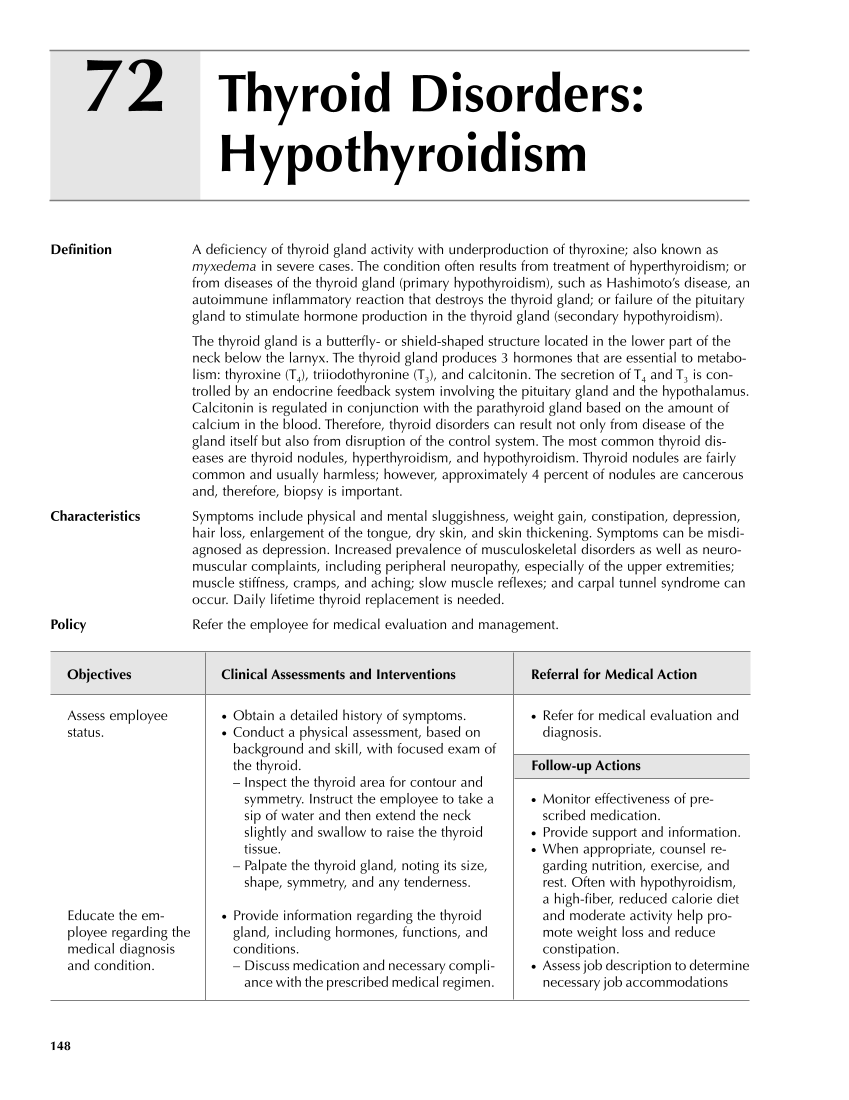72 148 Definition A deficiency of thyroid gland activity with underproduction of thyroxine also known as myxedema in severe cases. The condition often results from treatment of hyperthyroidism or from diseases of the thyroid gland (primary hypothyroidism), such as Hashimoto’s disease, an autoimmune inflammatory reaction that destroys the thyroid gland or failure of the pituitary gland to stimulate hormone production in the thyroid gland (secondary hypothyroidism). The thyroid gland is a butterfly- or shield-shaped structure located in the lower part of the neck below the larnyx. The thyroid gland produces 3 hormones that are essential to metabo- lism: thyroxine (T4), triiodothyronine (T3), and calcitonin. The secretion of T4 and T3 is con- trolled by an endocrine feedback system involving the pituitary gland and the hypothalamus. Calcitonin is regulated in conjunction with the parathyroid gland based on the amount of calcium in the blood. Therefore, thyroid disorders can result not only from disease of the gland itself but also from disruption of the control system. The most common thyroid dis- eases are thyroid nodules, hyperthyroidism, and hypothyroidism. Thyroid nodules are fairly common and usually harmless however, approximately 4 percent of nodules are cancerous and, therefore, biopsy is important. Characteristics Symptoms include physical and mental sluggishness, weight gain, constipation, depression, hair loss, enlargement of the tongue, dry skin, and skin thickening. Symptoms can be misdi- agnosed as depression. Increased prevalence of musculoskeletal disorders as well as neuro- muscular complaints, including peripheral neuropathy, especially of the upper extremities muscle stiffness, cramps, and aching slow muscle reflexes and carpal tunnel syndrome can occur. Daily lifetime thyroid replacement is needed. Policy Refer the employee for medical evaluation and management. Objectives Clinical Assessments and Interventions Referral for Medical Action Thyroid Disorders: Hypothyroidism ● Refer for medical evaluation and diagnosis. Follow-up Actions ● Monitor effectiveness of pre- scribed medication. ● Provide support and information. ● When appropriate, counsel re- garding nutrition, exercise, and rest. Often with hypothyroidism, a high-fiber, reduced calorie diet and moderate activity help pro- mote weight loss and reduce constipation. ● Assess job description to determine necessary job accommodations Assess employee status. Educate the em- ployee regarding the medical diagnosis and condition. ● Obtain a detailed history of symptoms. ● Conduct a physical assessment, based on background and skill, with focused exam of the thyroid. – Inspect the thyroid area for contour and symmetry. Instruct the employee to take a sip of water and then extend the neck slightly and swallow to raise the thyroid tissue. – Palpate the thyroid gland, noting its size, shape, symmetry, and any tenderness. ● Provide information regarding the thyroid gland, including hormones, functions, and conditions. – Discuss medication and necessary compli- ance with the prescribed medical regimen. Guideline continues on next page
Purchased from OEM Press by (ge corporate access). (C) 2013 OEM Health Information, Inc. All rights reserved.












































































































































































































































































































































































































































